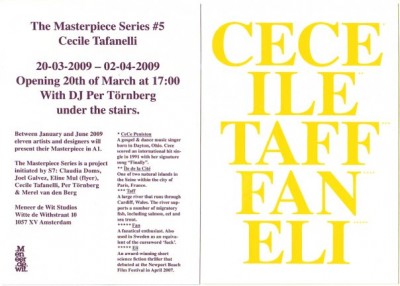Masterpieces in A1
Meneer de Wit Studios, Witte de Witstraat 10, 1058 XV Amsterdam
The Masterpiece Series is a changing exhibition in the showcase of Meneer de Wit.
11 artists & designers were asked to make a Masterpiece in A1 format. There were no restrictions concerning content and technique.
Between January and June 2009 these works will be presented in a 2-weeks-cycle in the showcase of Meneer de Wit and will be accompanied by a grand opening.
We invite you to another opening of the 5th Masterpiece in this series, made by Cecile Tafanelli
You are very welcome to join us for the opening on Friday the 20th of March at 17:00h at Witte de Withstraat 10.
Hope to see you there,
S7
Cécile Tafanelli
(20 March—2 April)
It is impossible to consciously produce a masterpiece, since it is a cultural term which posteriorly defines an existing work of art as such. A masterpiece is like a step-stone in art history books, it defines an era, an art movement, and often it transcends it. But again it is a cultural term invented to vulgarise art-history for popular culture, therefore so-called masterpieces often become cliché (to speak of painters; almost all Van Gogh, Impressionist painters, Klimt, Leonardo da Vinci and Renaissance iconic paintings, Dali, Matisse, Rothko, Miro, Hopper and many others that we can find reproduced in many waiting-rooms around the world, for obvious aesthetic reasons).
I chose to work with a painting from Leonardo da Vinci, but possibly finished by one of his students: Giovanni Antonio Boltraffio. The painting is called Madonna Litta (1490).
The Renaissance period of art-history began in Italy at the end of the XIV century and spread throughout Europe. It creates a sort of loop in art-history, jumping over the Middle Ages but also propping itself upon it, to rediscover antique arts and themes—especially Greek and Roman mythology. Renaissance painting also widely uses biblical imagery and classical themes (pieta, nativity, annunciation), but frees itself from the religious aspirations of Gothic painting by introducing a humanist purpose to the painting which spreads a sense of happiness, ideals, peace and progress. This ideological progress will be linked to technical progress as well, with the use of perspective, chiaroscuro, sfumato and so on. Renaissance is also the start of what is called the early Modern Age, as well as the birth of the status of the artist as we still know it today.
Renaissance is thought of as being a ‘digested’ period, because we are now in what is called the Postmodern world.
What struck me in many Renaissance paintings, was the inside/outside depiction, the subject shown inside a house with a view over hills or mountains, sometime

